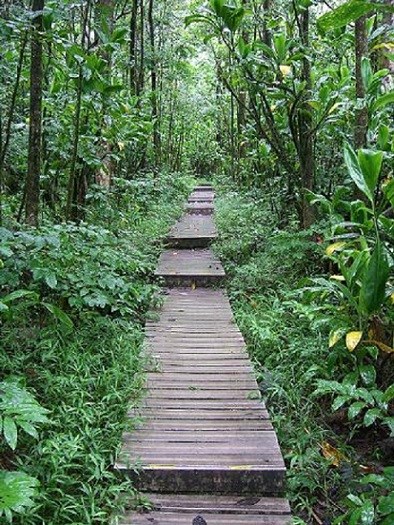Last updated: February 1, 2023
Article
The Biological and Cultural Richness found in the Pacific Islands

NPS Photo/Janice Wei
Images credited to NPS without any copyright symbol are public domain.
Introduction
The Pacific Islands are unique places scattered across the Pacific Ocean, known for their beauty and rich biodiversity. Volcanoes, beaches, and rainforests coexist on the same small pieces of land, a phenomenon hard to find elsewhere. The volcanoes, both active and dormant, create an amazing scene. Active volcanoes shape the earth around them with flowing lava, creating an ever-changing landscape. Dormant volcanoes stand tall, towering over islands and their bordering waters. The native rainforests of the Pacific Islands, and much of the wildlife within them, cannot be found anywhere else. Similarly, pacific coral reefs support an ecosystem of unique animals and plants. The fish that live in these reefs are all different shapes, sizes, and colors – an example of the rich biodiversity the Pacific Islands are known for.
Ecosystems
The unique ecosystems of the Pacific Islands face particular challenges. Their distance from the mainland has isolated them from many mainland diseases and predators. However, as travel to the islands increased with human colonization, diseases and invasive species were introduced to the island and have proven to drastically harm the ecosystem. Many of the species that reside on islands are smaller, so when larger mainland species are introduced, they throw the ecosystem out of balance. This is happening all over the Pacific Islands with the introduction of species such as cats, pigs, and mainland birds. The mainland species prey on the native species or compete with them for resources, often winning the battle. It’s important to recognize the value of native species and habitats and protect them against these ongoing threats.
Culture
Indigenous peoples on these islands share sacred bonds with the earth and have strong cultural connections to their resources, creating distincts ways of life. They tend to rely heavily on their waterways, as fishing provides sustenance for many on the islands. They work to protect the ecosystem by following traditional methods of fishing as opposed to many places that utilize commercial fishing methods. Using traditional fishing methods is just one example of how the native people on these islands prioritize environmental protection for themselves and future generations.

NPS Photo
Images credited to NPS without any copyright symbol are public domain
One day I would like to visit Haleakalā National Park, located on the island of Maui. This park is split between two contrasting landscapes. At its summit, is a volcanic crater that supports wildlife, even on its rough terrain. Native rainforests make up the lower half of this National Park. Packed with beautiful plants and animals, this forest is a must-see spot for me. The environment is lush and vibrant, made up of greenery, waterfalls, and streams. I would love to spend a day hiking throughout this forest and explore the waterfalls. This ecosystem hosts a variety of rare wildlife I have never seen before. I would be interested to see the o’opu fish. This tiny stream fish, native to Hawaii, can climb waterfalls with its suction-like fins. O’opu groups can be seen climbing straight up the rock walls. This is a remarkable example of native species adapting to their habitats. Additionally, the one thing I would be most excited about is seeing the sunrise at Haleakalā National Park – a sight so popular that park visitors must make a reservation for it.
Conclusion
The Pacific Islands are one-of-a-kind locations, filled with abundant wildlife and spectacular sights. The unique landscapes and species found here are vital in maintaining ecological balance. The National Park Service works to protect the biodiversity and culture of these islands for generations to come. I hope I get the chance to visit one of the Pacific Islands one day.
Written by Sarah Desmarais
for "A Day in the Life of a Fellow" Article Series
National Park Service - Workforce Management Fellow
in Partnership with Northwest Youth Corps
